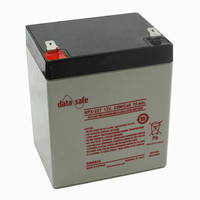NPX-25T EnerSys, NPX-25T Datasheet - Page 7

NPX-25T
Manufacturer Part Number
NPX-25T
Description
DATASAFE NPX LEAD ACID BATT 12V
Manufacturer
EnerSys
Specifications of NPX-25T
Voltage - Rated
12V
Rechargeability
Yes
Lead Free Status / RoHS Status
Contains lead / RoHS compliant by exemption
Size / Dimension
-
Termination Style
-
Capacity
-
Other names
Q5397175
www.enersys.com
Figures 1 and 2 may be used to determine battery size
(expressed in Ampere Hours of capacity), for a specific
application. To determine the capacity of the battery,
establish the discharge current for the length of discharge
time required. The point where the current and time lines
intersect is the minimum capacity battery needed for the
application. It is recommended you refer to Figures 3, 13, &
17 before making your final decision.
Figure 1. 20-Hour Rate Capacity Selection Chart
Figure 2. Capacity Selection Chart Genesis NPH Series
NPH Series Characteristics Curves
Battery Capacity Selection
10
60
40
20
10
8
6
4
3
2
6
3
➞
100
200
mA
300 400
DISCHARGE CURRENT
DISCHARGE CURRENT
600 800 1000
NPH2-12
➞
➞
2
3
NPH3.2-12
4
A
6
AT 25ºC (77ºF)
8
AT 25ºC (77ºF)
10
➞
20
■
The curves shown in Figures 1, 2, 3, & 4 and the discharge
rates shown in Tables 1, 2, & 3 illustrate the typical discharge
characteristics of Genesis NP and Genesis NPH batteries at an
ambient temperature of 25˚C (77˚F). The symbol “C”
expresses the nominal capacity of the Genesis NP battery,
measured at a 20 hour discharge rate and the Genesis NPH
at a 10 hour discharge rate. Please refer to General
Specifications to determine the nominal capacity rating of
the specific model.
The industry standard for designating the nominal capacity of
a sealed lead acid battery involves a discharge test for a given
number of hours to a final pre-set end voltage. The average
current value multiplied by the hours of discharge time
determines the capacity rating of that particular battery.
Since manufacturers vary in their rating standards, it is
always a good practice to question the rating standard.
Tables 1 and 2 show how the rated nominal capacity
decreases when the discharge load is higher than the 20
hour rate. These tables should be consulted when selecting
a battery for a high discharge application.
The discharge rates depicted in Table 2.5 reference watts
per cell of the DataSafe NPX series of batteries. These
batteries are designed for Uninterruptable Power Supply
(UPS) applications where high rate discharge performance
(under 30 minutes) is typical. To determine the battery
kilowatt rating required for a UPS system, refer to the
following formula: KVA rating of UPS x Power Factor (Pf)
÷ inverter effi ciency = Total Battery Kilowatts (KWB)
Figure 4. Discharge Characteristic Curves: Genesis NPH Batteries
Figure 3. Discharge Characteristic Curves: Genesis NP Batteries
Discharge
Discharge Characteristics
Publication No: US-NP-AM-002 • June 2006
.
7













